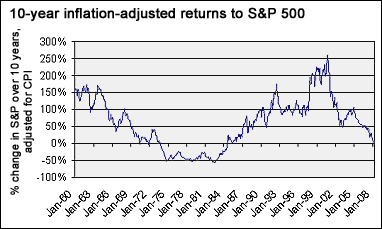1) Spengler is wonderfully provocative to read. He certainly isn't the only one saying "It's the demographics, stupid!" Where else could they put the money, even if the investments were dodgy? If I could go short on euros for a long period - 10-20 years - I think I'd make money.
2)the graph you present is 10 year adjusted total return - I interpret that as saying if you bought a 500 index fund in 1998, then in 2008 you are even, after discounting value for inflation. Is that how you see it?
3) you left out his best line, at the end of the op-ed
"Economics simply does not offer a solution to a lapse of the will to live among some of the world's richest economies. The Europeans are paying for their own nihilism. Having invented the perfect post-Christian society with cradle-to-grave services, they have not found anyone willing to live in it, except for the immigrants who well may inherit it from the disappearing locals. "
Michael,
Alas, perhaps you will be more willing to question and challenge Bob Walsh's "Walshian Assumptions", key of which is an ASSUMED 8.5% annual return on contributions into the Pension System.
As the graph clearly demonstrates, his silly 8.5% return assumption is garbage over the 50-60 year life of a contributor / pensioner.
But Bob Walsh could care less about the real returns, as he and his flock have ZERO Risk.
The taxpayers can eat cake, while real returns actually decline and his flock get COLA increases!
Sadly, guys like Walsh wreak havoc without challenge.
Indeed, as the Automotive and Steel industries apparently didn't wake people up to the destructive and unsustainable nature of nutty Union ENTITLEMENTS, one need only look to Europe (Germany, France, Italy..) to see the future of what Bob Walsh and his Union bretheren are creating here in RI with their Union Nanny-State.
"the graph you present is 10 year adjusted total return - I interpret that as saying if you bought a 500 index fund in 1998, then in 2008 you are even, after discounting value for inflation. Is that how you see it?"
Andrew, is that what that graph mean? (I admit, I don't quite get item #2 of this post.)
Monique,
What the graph means is that Bob Walsh's "Walshian Assumptions" are bull-shit (that's a techinical term).
Walsh depends on 8.65% annual growth, which the fool uses to support keeping the Public Employee Defined Benefit Pension Plans in place.
In fact, as the Graph demonstrates, over the last 48 years, we've had sustained growth over just 20 of those years (from 1981 to 2001). In all other years, we've actually had declines.
As Spengler noted: "Between 1981 and 2001, however, $1 invested in the stock market would have grown to $6 inflation-adjusted dollars. That was the greatest period of wealth creation in the past century of American finance." During this period, the average annual growth rate was Walshian at about 9%.
But then it was ALL lost. And that is the problem with Walsh's assumptions. His flock does not share in that RISK. The get their GUARANTEED benefit, even when the "growth" reverses itself as it did.
In fact, we've had no growth since 1998, as highlighted by Spengler: "After inflation, an investor who bought $1 worth of the S&P 500 in early 1998, just as the bubble was getting underway, would be able to sell this position and buy $1 worth of consumption goods today."
And it is worse, as these are inflation adjusted numbers, where as Bob's flock gets the automatic COLA increase, further exacerbating the reeming that Bob is applying to the taxpayers.
Bottom line, Bob won't be sharing this anlaysis with the "Commission".
To clarify a few points:
The chart shows absolute (not annualized real returns on the S&P 500 Index over the 10 years ended on the dates shown in the x axis of the chart.
The 8.25% figure used by Bob Walsh is an annual nominal return on a portfolio -- that is, it includes inflation.
The two really aren't directly comparable. One is an absolute 10 year return on a single asset class. Bob's 8.25% is assumed annualized nominal return on a portfolio composed of multiple asset classes and, within them, a mix of active and passive investment management strategies.
A better comparison to Bob W's figures are the nominal rates of return assumed on private sector defined benefit pension plans or university endowment plans. Another approach is to subtract a 3% inflation rate (the long term average) from the 8.25% nominal assumed return. Alternatively, you could take the difference between long dated nominal Treasuries and TIPS (real return bonds) for your forward looking inflation assumption, and subtract that from the 8.25%.
Still waiting for P. Crowley's investment management insights. They are bound to be entertaining...
On one hand, I'm an advocate of 401(k)s for new state hires (while still questioning the fairness of conversion for current workers in the pension system). On the other, after seeing my 401(k) lose about $2,000 in the first quarter, including my own and my employer's contribution,...
Rhody,
And what does that prove? Do you think that no defined benefit pension plan or endowment plan has had a tough first quarter? Checked out the data on hedge fund closures lately?
What exactly is your point?
To Clarify a few points:
John is correct. These are ABSOLUTE returns. They are Not "ASSUMED" or "hoped for" returns.
Bob Walsh wants to Assume that the Pension fund will return 8.5% EVERY year.
This Chart shows that for this asset class, which is typically a significant portion of a Pension fund, 8.5% returns every year do NOT happen, no matter how much you ASSUME or HOPE they do.
Some years, returns will be good. But often times, you end up giving those returns right back via losses.
For example, there are NO returns from 1998 to 2008, after adjusting for Inflation.
The point is that Bob Walsh's "Walshian Assumptions" are just that, Assumptions. And they are rosy Assumptions. A Pensioner contributes over a period of 20-30 years and colects for 25 -30 years.
8.25% annual returns over 45 - 60 years do NOT easily happen. But, that is NOT Bob Walsh's concern, as his flock gets their GAURANTEED benefit, regardless. They have ZERO Risk and all REWARD.
Let me try to make it simple:
Spengler noted that "Americans borrowed a trillion dollars a year against the expectation that the 10% annual rate of increase in home prices would continue, producing a bubble that now has collapsed" leaving us in a massive hole of debt.
Similarly, Bob Walsh wants us to take on massive Pension Liabilities (i.e. debt) based on the faulty assumption that the Plan assets will return 8.5% in perpetuity.
It will appear to work for a relatively short period of time, but then bubble bursts and the taxpayers are left holding the bag, while Bob's flock collects their Pension tax free in Florida.
Monique,
Each point on the graph tells you how an investment in an S&P 500 index fund from a decade earlier would have grown (or lost). For example, the "100%" figure near Jan 90 means whatever you had in your fund in Jan 80 would have doubled by Jan 90.
Does someone with knowledge of financial and market history know if the Carter administration (or the Fed chairman at the time) was doing anything specific that was responsible for that Death Valley period at the bottom of the graph?
In all the Carter and some early Reagan years, we had the overhangs from Vietnam expenditures and the first oil price shock. Anyone in the market to buy or sell a house then will remember mortgage rates that looked like credit card rates.
That 8.5% Walshian assumption doesn't factor in inflation adjustments. You can't use this graph to damn the assumption, although it is damnable. The only way you get this rate of return historically is in the stock market. Is Mr. Walsh advocating that the whole pension fund be in the market? This 8.5% number is like a magician's misdirection. It diverts us from looking at what will happen until all the Plan A people have retired and then gone to their reward.
Let me take a crack at that graph. $1 in 1950 grows to $1.50 in 1960 grows $1.80 in 1970 shrinks to $0.90 in 1980 grows to $1.50 in 1990 grows to $3.45 in 2000 and is still at $3.45 in 2008, but with a bad trendline.
Andrew,
Death Valley was the period of massive INFLATION. Remember, "who needs inflation, not this nation...".
The graph shows real returns, adjusted for inflation.
Paul Volker, Fed Chairman, broke the back of inflation in the 80s via big increases in interest rates.
We are going into a similar period now.
In the news a few months ago, I believe it was the City of Woonsocket, that lost something like $13m of value in their Pension fund due to the down-turn in the market. They said "Wooops, the Walshian Assumptions didn't quite hold up."
But again, for the precious Union, these realities are of no consequence. They don't live in the real world. They get Guaranteed benefits, adjusted for inflation, regardless of what is happening in the Free Market.
They are kept artificially afloat by the taxpayers who must deal with the ebbs and flows of the free market.
And then you have the Bob Walsh's shouting from their safe perch, "don't worry, ignore the $5B Pension deficit my flock has saddled you with, it will all be gone in 22 years ....assuming my rosy Assumptions come to fruition ...and if they don't, no matter, we'll have gotten what we are ENTITLED to"
Chuck,
I think you're off by a hypothetical dollar. The zero line would represent no change in the investment; $1 ten years ago would represent $1 now.
The 50% line would be a 50% gain on a ten-year investment investment, $1.50"now" for $1.00 10 years ago.
So the 150% starting point in January 1960 represents *$2.50* in the fund, for every $1.00 in the fund in 1950.
Whether its a multiplier or additive (as you suggest), its pretty impressive if you hold long enough, say over the period of a private sector career of 40+ years. The problem remains that you can't trust politicians - or companies - to manage defined benefit plans. In good times, when the returns are good, they short the contributions they make and in bad times, they short the contributions they make because the money isn't there. And of course, the politicians buy votes by designing plans that would get an actuary sent to jail. Unsustainable even with sizable employee contributions.
John, I'm just offering a little anecdotal evidence that pushing everyone into 401(k) isn't the magic bullet.
Instead of pointing the fingers at pension recipients, we ought to be pointing our fingers at the investment class (who bear much of the responsibility for rising oil prices)/
Two points.
First, $100 compounded at 5.25% real (8.25% Walsh nominal assumption less 3% annual inflation assumption) equals $167. Draw a line across the chart at 67% absolute real increase and you will see how often this was realized over the time period shown.
Second, Rhody, (a) if you receive a pension, the underlying funds are invested and earn returns. In fact, if they consistently earned below benchmark returns, you would demand the investment manager be fired. Hence, I have no doubt that part of your prudently deiversified pension assets are invested in energy companies and/or commodities as an asset class. Therefore, like it or not, you are a member of the "investment class" you apparently hold in such disdain.
(b) If you keep up with the financial and economic press and research, you would know that there is an ongoing debate about the cause of the current spike in oil prices. One argument is that it reflects changing supply and demand conditions, including the rising cost of replacing reserves which are now depleting more rapidly because of the incremental demand from China, India and other rapidly developing countries. A second argument is that it also reflects tight supply conditions (read: limited Saudi ability to raise production if unpredictable political changes cause a fall off in Venezuelan, Nigerian, Iranian or some other country's productioin) in the face of still strong demand (though the latter may well fall sharply if and when the global economy follows the US into a recession). A third argument is that more investors choosing to diversify their portfolios to include an allocation to commodities has distorted futures market pricing, and fed back into the pricing of the underlying physical commodities.
In reality, all three forces are probably at work, and it is analytically impossible to disentangle their relative effects in real time.
So, please, let's dispense with the snide remards about the "investment class", shall we? Makes you sound right up there with David and his "corporate deviltry" posting.
John, you can't dismiss the role of speculators. As you point out, we who have money in mutual funds are technically part of the investment class, but we don't move the markets.
T. Boone Pickens opens his big yap, and oil goes up $2 more a barrel. There is a class of investors responsible for boosting the price of oil far beyond where the laws of supply and demand would put it. We need to rise up and just say no to these forces tampering with the free market.
Rhody,
The latest data from the International Energy Agency show that the supply and demand for petroleum is still quite finely balanced, with little in the way of spare capacity. The most likely resolution is a fall in prices as the global economy slows and demand for oil products falls. To the extent that this forces leveraged speculative positions to be quickly unwound (e.g. due to an inability to meet margin calls) it will accelerate the price fall. In the meantime, however, I continue to conclude that the current price of oil primarily reflects supply and demand conditions, plus a further premimum caused by buyers building up reserves as a hedge against supply side disruptions. I just don't see financial speculation as being anywhere near as important as these basic physical and political realities.
Gents -
You're getting way off track with a discussion of the nuances of the energy markets.
Let's stick to the original subject, which is how appropriate are the "Walshian Assumptions" in justifying Defined Benefit Plans for his flock.
We'll need Andrew's help / confirmation on this:
1) An 8.5% annual return over 10 years (the Walshian Assumption) would result in a point on the graph equal to 226%. So how often did the graph reach that "Walshian Assumption" return level? VERY FEW times.
2) An annual return of 4.14% would result in a point of the graph equal to 150%. How often did the graph intersect with 150% Again, NOT OFTEN.
The point is that the "Walshian Assumptions" of 8.5% annual returns are hardly realistic on a consistent and sustainable basis.
Two caveats -
1) Walsh's assumptions are not reduced for infaltion, however, since his Pensioners are not suffering the degredation of inflation (as they receive COLAs), I don't think it is fair to reduce his Walshian Assumption of 8.5%. But even if you did, it would be that much harder for his numbers to work.
2) It is true that this graph represents just one, of potentially many, asset classes. However, it is certainly representative of real returns accross asset classes.
The point is that there are some years when returns will be great, but most years they don't come anywhere near the "Walshian Assumptions" needed to justify Bob Walsh's indefensible defense of Defined Benefit Plans coupled with the terms of the Benefits provided (i.e. Guaranteed 75% Pensions, COLAs, short # of years contributing, etc.)
Andrew, please advise if my math is wrong.
Rhody, you have FINALLY said something I can agree with. "We need to rise up and just say no to these forces tampering with the free market."
I couldn't agree more. We need to say NO to the Unions that refuse to allow the Free Market to determine their worth. Particularly the monopolistic Teachers' Union.
Will you join me in demanding that RI at least becomes a "right to work state"?





 About Community Crier
About Community Crier

 About Engaged Citizen
About Engaged Citizen Administrator
Administrator




1) Spengler is wonderfully provocative to read. He certainly isn't the only one saying "It's the demographics, stupid!" Where else could they put the money, even if the investments were dodgy? If I could go short on euros for a long period - 10-20 years - I think I'd make money.
2)the graph you present is 10 year adjusted total return - I interpret that as saying if you bought a 500 index fund in 1998, then in 2008 you are even, after discounting value for inflation. Is that how you see it?
3) you left out his best line, at the end of the op-ed
"Economics simply does not offer a solution to a lapse of the will to live among some of the world's richest economies. The Europeans are paying for their own nihilism. Having invented the perfect post-Christian society with cradle-to-grave services, they have not found anyone willing to live in it, except for the immigrants who well may inherit it from the disappearing locals. "
Posted by: chuckR at May 20, 2008 12:52 PMMichael,
Alas, perhaps you will be more willing to question and challenge Bob Walsh's "Walshian Assumptions", key of which is an ASSUMED 8.5% annual return on contributions into the Pension System.
As the graph clearly demonstrates, his silly 8.5% return assumption is garbage over the 50-60 year life of a contributor / pensioner.
But Bob Walsh could care less about the real returns, as he and his flock have ZERO Risk.
The taxpayers can eat cake, while real returns actually decline and his flock get COLA increases!
Sadly, guys like Walsh wreak havoc without challenge.
Indeed, as the Automotive and Steel industries apparently didn't wake people up to the destructive and unsustainable nature of nutty Union ENTITLEMENTS, one need only look to Europe (Germany, France, Italy..) to see the future of what Bob Walsh and his Union bretheren are creating here in RI with their Union Nanny-State.
Posted by: George Elbow at May 20, 2008 6:34 PM"the graph you present is 10 year adjusted total return - I interpret that as saying if you bought a 500 index fund in 1998, then in 2008 you are even, after discounting value for inflation. Is that how you see it?"
Andrew, is that what that graph mean? (I admit, I don't quite get item #2 of this post.)
Posted by: Monique at May 20, 2008 8:19 PMMonique,
What the graph means is that Bob Walsh's "Walshian Assumptions" are bull-shit (that's a techinical term).
Walsh depends on 8.65% annual growth, which the fool uses to support keeping the Public Employee Defined Benefit Pension Plans in place.
In fact, as the Graph demonstrates, over the last 48 years, we've had sustained growth over just 20 of those years (from 1981 to 2001). In all other years, we've actually had declines.
As Spengler noted: "Between 1981 and 2001, however, $1 invested in the stock market would have grown to $6 inflation-adjusted dollars. That was the greatest period of wealth creation in the past century of American finance." During this period, the average annual growth rate was Walshian at about 9%.
But then it was ALL lost. And that is the problem with Walsh's assumptions. His flock does not share in that RISK. The get their GUARANTEED benefit, even when the "growth" reverses itself as it did.
In fact, we've had no growth since 1998, as highlighted by Spengler: "After inflation, an investor who bought $1 worth of the S&P 500 in early 1998, just as the bubble was getting underway, would be able to sell this position and buy $1 worth of consumption goods today."
And it is worse, as these are inflation adjusted numbers, where as Bob's flock gets the automatic COLA increase, further exacerbating the reeming that Bob is applying to the taxpayers.
Bottom line, Bob won't be sharing this anlaysis with the "Commission".
Posted by: George Elbow at May 20, 2008 10:09 PMTo clarify a few points:
The chart shows absolute (not annualized real returns on the S&P 500 Index over the 10 years ended on the dates shown in the x axis of the chart.
The 8.25% figure used by Bob Walsh is an annual nominal return on a portfolio -- that is, it includes inflation.
The two really aren't directly comparable. One is an absolute 10 year return on a single asset class. Bob's 8.25% is assumed annualized nominal return on a portfolio composed of multiple asset classes and, within them, a mix of active and passive investment management strategies.
A better comparison to Bob W's figures are the nominal rates of return assumed on private sector defined benefit pension plans or university endowment plans. Another approach is to subtract a 3% inflation rate (the long term average) from the 8.25% nominal assumed return. Alternatively, you could take the difference between long dated nominal Treasuries and TIPS (real return bonds) for your forward looking inflation assumption, and subtract that from the 8.25%.
Still waiting for P. Crowley's investment management insights. They are bound to be entertaining...
Posted by: John at May 20, 2008 11:21 PMOn one hand, I'm an advocate of 401(k)s for new state hires (while still questioning the fairness of conversion for current workers in the pension system). On the other, after seeing my 401(k) lose about $2,000 in the first quarter, including my own and my employer's contribution,...
Posted by: rhody at May 21, 2008 1:02 AMRhody,
And what does that prove? Do you think that no defined benefit pension plan or endowment plan has had a tough first quarter? Checked out the data on hedge fund closures lately?
What exactly is your point?
Posted by: John at May 21, 2008 1:05 AMTo Clarify a few points:
John is correct. These are ABSOLUTE returns. They are Not "ASSUMED" or "hoped for" returns.
Bob Walsh wants to Assume that the Pension fund will return 8.5% EVERY year.
This Chart shows that for this asset class, which is typically a significant portion of a Pension fund, 8.5% returns every year do NOT happen, no matter how much you ASSUME or HOPE they do.
Some years, returns will be good. But often times, you end up giving those returns right back via losses.
For example, there are NO returns from 1998 to 2008, after adjusting for Inflation.
The point is that Bob Walsh's "Walshian Assumptions" are just that, Assumptions. And they are rosy Assumptions. A Pensioner contributes over a period of 20-30 years and colects for 25 -30 years.
8.25% annual returns over 45 - 60 years do NOT easily happen. But, that is NOT Bob Walsh's concern, as his flock gets their GAURANTEED benefit, regardless. They have ZERO Risk and all REWARD.
Posted by: George Elbow at May 21, 2008 7:06 AMLet me try to make it simple:
Spengler noted that "Americans borrowed a trillion dollars a year against the expectation that the 10% annual rate of increase in home prices would continue, producing a bubble that now has collapsed" leaving us in a massive hole of debt.
Similarly, Bob Walsh wants us to take on massive Pension Liabilities (i.e. debt) based on the faulty assumption that the Plan assets will return 8.5% in perpetuity.
It will appear to work for a relatively short period of time, but then bubble bursts and the taxpayers are left holding the bag, while Bob's flock collects their Pension tax free in Florida.
Posted by: George Elbow at May 21, 2008 7:36 AMMonique,
Each point on the graph tells you how an investment in an S&P 500 index fund from a decade earlier would have grown (or lost). For example, the "100%" figure near Jan 90 means whatever you had in your fund in Jan 80 would have doubled by Jan 90.
Does someone with knowledge of financial and market history know if the Carter administration (or the Fed chairman at the time) was doing anything specific that was responsible for that Death Valley period at the bottom of the graph?
Posted by: Andrew at May 21, 2008 7:42 AMIn all the Carter and some early Reagan years, we had the overhangs from Vietnam expenditures and the first oil price shock. Anyone in the market to buy or sell a house then will remember mortgage rates that looked like credit card rates.
That 8.5% Walshian assumption doesn't factor in inflation adjustments. You can't use this graph to damn the assumption, although it is damnable. The only way you get this rate of return historically is in the stock market. Is Mr. Walsh advocating that the whole pension fund be in the market? This 8.5% number is like a magician's misdirection. It diverts us from looking at what will happen until all the Plan A people have retired and then gone to their reward.
Let me take a crack at that graph. $1 in 1950 grows to $1.50 in 1960 grows $1.80 in 1970 shrinks to $0.90 in 1980 grows to $1.50 in 1990 grows to $3.45 in 2000 and is still at $3.45 in 2008, but with a bad trendline.
Posted by: chuckR at May 21, 2008 8:11 AMAndrew,
Death Valley was the period of massive INFLATION. Remember, "who needs inflation, not this nation...".
The graph shows real returns, adjusted for inflation.
Paul Volker, Fed Chairman, broke the back of inflation in the 80s via big increases in interest rates.
We are going into a similar period now.
In the news a few months ago, I believe it was the City of Woonsocket, that lost something like $13m of value in their Pension fund due to the down-turn in the market. They said "Wooops, the Walshian Assumptions didn't quite hold up."
But again, for the precious Union, these realities are of no consequence. They don't live in the real world. They get Guaranteed benefits, adjusted for inflation, regardless of what is happening in the Free Market.
They are kept artificially afloat by the taxpayers who must deal with the ebbs and flows of the free market.
And then you have the Bob Walsh's shouting from their safe perch, "don't worry, ignore the $5B Pension deficit my flock has saddled you with, it will all be gone in 22 years ....assuming my rosy Assumptions come to fruition ...and if they don't, no matter, we'll have gotten what we are ENTITLED to"
Posted by: George Elbow at May 21, 2008 8:20 AMChuck,
I think you're off by a hypothetical dollar. The zero line would represent no change in the investment; $1 ten years ago would represent $1 now.
The 50% line would be a 50% gain on a ten-year investment investment, $1.50"now" for $1.00 10 years ago.
So the 150% starting point in January 1960 represents *$2.50* in the fund, for every $1.00 in the fund in 1950.
Posted by: Andrew at May 21, 2008 9:19 AMWhether its a multiplier or additive (as you suggest), its pretty impressive if you hold long enough, say over the period of a private sector career of 40+ years. The problem remains that you can't trust politicians - or companies - to manage defined benefit plans. In good times, when the returns are good, they short the contributions they make and in bad times, they short the contributions they make because the money isn't there. And of course, the politicians buy votes by designing plans that would get an actuary sent to jail. Unsustainable even with sizable employee contributions.
Posted by: chuckR at May 21, 2008 11:12 AMJohn, I'm just offering a little anecdotal evidence that pushing everyone into 401(k) isn't the magic bullet.
Posted by: rhody at May 21, 2008 11:12 AMInstead of pointing the fingers at pension recipients, we ought to be pointing our fingers at the investment class (who bear much of the responsibility for rising oil prices)/
Two points.
First, $100 compounded at 5.25% real (8.25% Walsh nominal assumption less 3% annual inflation assumption) equals $167. Draw a line across the chart at 67% absolute real increase and you will see how often this was realized over the time period shown.
Second, Rhody, (a) if you receive a pension, the underlying funds are invested and earn returns. In fact, if they consistently earned below benchmark returns, you would demand the investment manager be fired. Hence, I have no doubt that part of your prudently deiversified pension assets are invested in energy companies and/or commodities as an asset class. Therefore, like it or not, you are a member of the "investment class" you apparently hold in such disdain.
(b) If you keep up with the financial and economic press and research, you would know that there is an ongoing debate about the cause of the current spike in oil prices. One argument is that it reflects changing supply and demand conditions, including the rising cost of replacing reserves which are now depleting more rapidly because of the incremental demand from China, India and other rapidly developing countries. A second argument is that it also reflects tight supply conditions (read: limited Saudi ability to raise production if unpredictable political changes cause a fall off in Venezuelan, Nigerian, Iranian or some other country's productioin) in the face of still strong demand (though the latter may well fall sharply if and when the global economy follows the US into a recession). A third argument is that more investors choosing to diversify their portfolios to include an allocation to commodities has distorted futures market pricing, and fed back into the pricing of the underlying physical commodities.
In reality, all three forces are probably at work, and it is analytically impossible to disentangle their relative effects in real time.
So, please, let's dispense with the snide remards about the "investment class", shall we? Makes you sound right up there with David and his "corporate deviltry" posting.
Posted by: John at May 21, 2008 1:27 PMJohn, you can't dismiss the role of speculators. As you point out, we who have money in mutual funds are technically part of the investment class, but we don't move the markets.
Posted by: rhody at May 21, 2008 2:29 PMT. Boone Pickens opens his big yap, and oil goes up $2 more a barrel. There is a class of investors responsible for boosting the price of oil far beyond where the laws of supply and demand would put it. We need to rise up and just say no to these forces tampering with the free market.
Rhody,
The latest data from the International Energy Agency show that the supply and demand for petroleum is still quite finely balanced, with little in the way of spare capacity. The most likely resolution is a fall in prices as the global economy slows and demand for oil products falls. To the extent that this forces leveraged speculative positions to be quickly unwound (e.g. due to an inability to meet margin calls) it will accelerate the price fall. In the meantime, however, I continue to conclude that the current price of oil primarily reflects supply and demand conditions, plus a further premimum caused by buyers building up reserves as a hedge against supply side disruptions. I just don't see financial speculation as being anywhere near as important as these basic physical and political realities.
Posted by: John at May 21, 2008 4:41 PMGents -
You're getting way off track with a discussion of the nuances of the energy markets.
Let's stick to the original subject, which is how appropriate are the "Walshian Assumptions" in justifying Defined Benefit Plans for his flock.
We'll need Andrew's help / confirmation on this:
1) An 8.5% annual return over 10 years (the Walshian Assumption) would result in a point on the graph equal to 226%. So how often did the graph reach that "Walshian Assumption" return level? VERY FEW times.
2) An annual return of 4.14% would result in a point of the graph equal to 150%. How often did the graph intersect with 150% Again, NOT OFTEN.
The point is that the "Walshian Assumptions" of 8.5% annual returns are hardly realistic on a consistent and sustainable basis.
Two caveats -
1) Walsh's assumptions are not reduced for infaltion, however, since his Pensioners are not suffering the degredation of inflation (as they receive COLAs), I don't think it is fair to reduce his Walshian Assumption of 8.5%. But even if you did, it would be that much harder for his numbers to work.
2) It is true that this graph represents just one, of potentially many, asset classes. However, it is certainly representative of real returns accross asset classes.
The point is that there are some years when returns will be great, but most years they don't come anywhere near the "Walshian Assumptions" needed to justify Bob Walsh's indefensible defense of Defined Benefit Plans coupled with the terms of the Benefits provided (i.e. Guaranteed 75% Pensions, COLAs, short # of years contributing, etc.)
Andrew, please advise if my math is wrong.
Rhody, you have FINALLY said something I can agree with. "We need to rise up and just say no to these forces tampering with the free market."
I couldn't agree more. We need to say NO to the Unions that refuse to allow the Free Market to determine their worth. Particularly the monopolistic Teachers' Union.
Will you join me in demanding that RI at least becomes a "right to work state"?
Posted by: George Elbow at May 21, 2008 6:57 PM